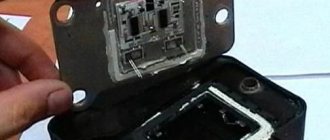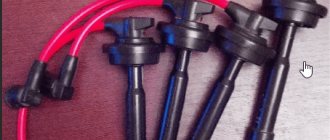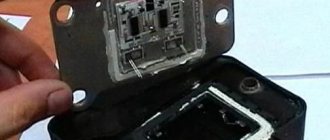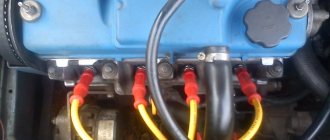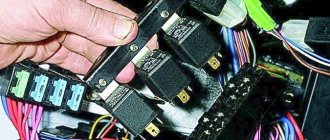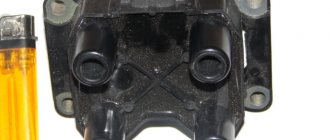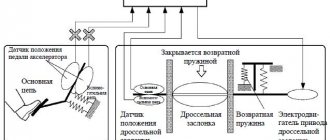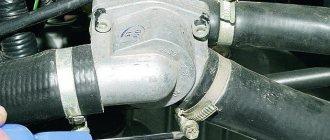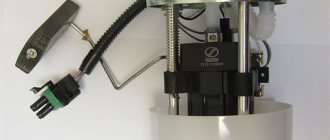The design of any car requires impulse conductors from the ignition system to the fuel combustion system (directly to the spark plugs). They are also found in the VAZ 2114. These are high-voltage (HV) wires. When the impulse does not pass or the discharge has insufficient power, the gasoline in the cylinders does not burn completely, and the engine operates intermittently.
High-voltage wires VAZ 2102
Therefore, it is very important to know what resistance should be on the high-voltage wires of the VAZ 2114, and what needs to be done if it does not meet the standard.
How to check high-voltage (HV) wires and determine their resistance
The main task of high-voltage wires is to transmit a current pulse from the ignition coil to the spark plug.
Timely and guaranteed ignition of the fuel in the cylinder depends on the quality of current transmission, which entails normal, correct operation of the engine.
For various reasons, high-voltage (HV) wires may not conduct at all or conduct only a small part of the current pulse from the ignition to the spark plug.
The main reasons for the malfunction of explosive wires are the following:
- core rupture;
- current leakage (breakdown through insulation);
- resistance is higher than normal;
- poor contact with the spark plug;
- rupture of the conductor.
With faulty explosive wires, the engine runs intermittently and produces extraneous vibrations, because In some cylinder the combustion of the mixture occurs with a delay.
Types of damage and malfunctions
- Breakage of current-carrying conductors in high-voltage wires.
- Damage to the wire insulation. Sometimes, just one accidental scratch on the insulation is enough for a current leak to occur that can cause problems.
- The conductor is oxidized. This damage is a direct result of torn insulation, which allows moisture to enter the core.
- High wire resistance. Here the fault lies with the manufacturer (alternatively, the car owner himself may be to blame for installing wires from a car of a different brand).
- Bad contacts. They in the wire caps wear out over time and no longer fit tightly to the spark plugs (or to the contacts on the ignition coil).
All of the above damage can lead to sparks and “stray” electromagnetic pulses that will interfere with the normal operation of the car’s sensors. In addition, if the conductor is broken, voltage will not be supplied to the spark plug in a timely manner. This will lead to the fact that the fuel-air mixture in the combustion chamber will ignite late, and one of the engine cylinders will always be “late”, that is, the synchronization of the cylinders will be disrupted.
Checking high voltage wires
The first sign of a wire malfunction is the presence of an external spark on the explosive wires. Easy to see in the dark by looking under the hood.
The next method is also best done in the dark: take a piece of wire and strip it on both sides. Next, we connect the wire with one end to ground (battery or car body), and with the other end we run it along the wires at the joints, caps, etc. if there is a leak, a spark will form.
To check the resistance of the wires, we need a multimeter in ohmmeter mode.
In order not to confuse the wires, it is more convenient to check them one by one, i.e. remove the wire from the 1st cylinder and remove the other end of this wire from the ignition module.
- Turn off the ignition.
- Remove one end of the wire from the cylinder.
- Remove the other end of the wire from the ignition module (as in the figure).
- We connect both ends to an ohmmeter and watch the readings.
- We carry out the same operation on all wires.
For serviceable wires, the resistance should vary from 3.5 to 10 kOhm, depending on the manufacturer (written on the wire insulation). And the permissible spread is 2-4 kOhm. If the spread is greater, then the wires need to be replaced ( Replacing VAZ high-voltage wires ).
How to check BB
Visual inspection
- All wires should be inspected for visible damage (scratches on insulation, severe bends, chips and cracks on contact caps, etc.)
- You also need to make sure that there are no breakdowns anywhere (that is, the wire does not short out anywhere and sparks do not jump anywhere). It is better to do this inspection in the dark, so you need to close the front door in the garage and turn off the lights.
- If the high-voltage wire is not broken and there are no breakdowns, you can try to use it to see if it is intact inside. One end of it is stripped and the “ground” is closed with it (that is, the wire is applied to the body of the car). We run the other end of the wire along other parts, contact caps, and joints. If there is damage in any area, a breakdown will occur (this procedure is also best carried out in the dark).
Checking with a multimeter
If a visual inspection fails to identify a fault, use a multimeter. It can be used to measure the resistance of each high-voltage wire.
- First, switch the multimeter to ohmmeter mode.
Multimeter set to ohmmeter mode
Then we disconnect the high-voltage wires from both the spark plugs and the contacts on the ignition coil.
High voltage wires disconnected from spark plug contacts and coil contacts
- The electrodes of the multimeter are connected in turn to the contacts of each high-voltage wire. Then the resistance is assessed, which is shown by the multimeter.
The resistance of the high-voltage wire is 4.8 kOhm, the wire is in good condition
In order to correctly evaluate the tester's readings, you should know exactly the resistance of the high-voltage wires of your car (this resistance is indicated on the packaging; alternatively, the resistance can be indicated directly on the insulation of each wire).
If the high-voltage wire is intact, the resistance shown by the multimeter varies in the range from 3.5 to 10 kOhm (what figure this will be depends on the brand of the wire, the material of the core and its length). If zero is visible on the multimeter, then this is a clear sign that the current-carrying wire is broken (although this may not be visible from the outside and the wire looks intact).
Verification video
Resistance of high voltage wires
We compare the results of the readings. The permissible spread on the wires is 2-4 kOhm. If more, then the explosive wires need to be replaced. By the way, you need to replace the wires as a set, not one at a time. Each manufacturer has a different high-voltage wire resistance.
Let's look at the most common wires:
- Tesla. Resistance 6 kOhm (fake Tesla 8 kOhm).
- Slon. Resistance from 4 to 7 kOhm (4 on the first and almost 7 on the last).
- ProSport. Resistance is almost 0.
- Cargen. Resistance 0.9 kOhm (each wire has a different resistance due to different lengths, rounded values are shown).
Source
Auto parts and service stations
The main task of the high-voltage wires of the ignition system of gasoline engines is to transmit the ignition pulse from the coil (coils) or ignition distributor to the spark plugs of the internal combustion engine.Along with this, high-voltage wires perform the following functions: ensuring high-quality insulation of high-voltage pulses; minimizing radio interference; protection against failure of ignition system elements. If the electrical parameters of the high-voltage wire are violated, the car engine begins to “triple”, there is a large loss of car power, and the car’s starting system may fail. Such a malfunction must be corrected immediately, as it can lead to a complete failure of the ignition system, malfunction of the vehicle’s mechanical components due to uneven engine operation.
Probable causes of malfunction The most common cause of malfunction of high-voltage wires is natural wear and aging. They are located in close proximity to the engine. During vehicle operation, especially in the cold season, the daily temperature difference can be more than 100 degrees Celsius. The insulating properties of the wire coating material gradually decrease. The wire begins to crack, moisture, vapors of aggressive liquids (antifreeze, washer fluid), oils, and salt solutions for treating road surfaces penetrate into it. Once the cracks reach the current-carrying conductor, a high-voltage signal can penetrate to ground. The insulating properties of the wire will be impaired, and the ignition impulse will not reach the spark plugs. Often wires lose their conductive properties as a result of mechanical stress. This usually occurs at the junction of the live conductor with the contact connectors of the spark plugs and ignition coils. When installing explosive wires, it is necessary to lay them correctly, be sure to attach polyester-vinyl crimp clamps, and avoid unnecessary mechanical forces. Wires can fail if the maximum high voltage level is exceeded. This situation is possible in the event of a breakdown of the coil along the primary winding.
How to check high voltage ignition wires?
Automotive high-voltage (HV) wires play an important role for internal combustion engines, since they help transmit high current from the ignition coil to the spark plugs. The serviceability and efficiency of the wires determines the timeliness and intensity of ignition of the fuel-air mixture, and therefore the correct and uninterrupted operation of the engine. Despite their simplicity, wires have many different “sores” and can cause a lot of troubles to their owner, which in one way or another will affect his nerves and pocket.
Malfunctions of high-voltage wires (common problems):
As a rule, the malfunction boils down to the fact that current either does not flow to the spark plug at all, or it does, but in limited quantities. This can happen for the following reasons:
- There has been a break in the conductor through which the impulse travels.
- There is a current leak, that is, the insulation is damaged and the current flows to the side.
- The resistance exceeds the permissible value.
- Problems in contacts (with a spark plug or ignition coil).
In the event of a break in the current-carrying wire, the effect of an internal spark occurs, in other words, an electrical discharge is formed between the ends of the broken wire, which reduces the voltage and causes an electromagnetic parasitic pulse. This impulse, in turn, negatively affects the correct operation of many of the vehicle's sensors. One such damaged high-voltage wire can cause vibration and interruptions in engine operation. Due to a damaged high-voltage wire, ignition in the cylinder occurs late or every other time, as a result, the synchronous operation of the cylinders and the engine as a whole is disrupted.
How to check high-voltage wires? Effective ways:
First of all, it is necessary to check the explosive for the absence of visible damage (cracks, fractures, etc.). Make sure there is no breakdown, this can be determined even without instruments, just look under the hood in the dark; in the event of a breakdown while the engine is running, a spark will be visible on the explosive wire. You can check high-voltage wires using a wire. To do this, you need to take a piece of wire in the dark and strip it on both sides. Then one end must be shorted to ground (machine body), and the other end must be drawn along the entire length of the explosive wires, as well as joints, caps, etc. A spark will form at the breakdown sites.
You can also check the resistance of the high voltage wires, for this you will need a multimeter. — Turn on the ohmmeter mode. — Remove the wire from the spark plug of the first cylinder and the ignition coil. — Connect the multimeter electrodes to the ends of the wire and look at the readings.
In good wires, the resistance should vary from 3.5 to 10 kOhm, depending on the type of wires themselves. Information about resistance is most often indicated on the insulation of high-voltage wires. Check each wire, the spread between them should not exceed 2-4 kOhm. If there is a large variation, replace the wires. By the way, they are changed as a set, that is, all together.
In conclusion, your resistance reading of the most popular high-voltage wires:
- Tesla - 6 kOhm
- Slon - from 4 kOhm to 7 kOhm (4 kOhm - 1st cylinder and up to 7 kOhm - on the last cylinder)
- ProSport - almost zero resistance
- Cargen - 0.9 kOhm
Note! The resistance of high-voltage wires varies depending on the length, thickness, and material from which the wires are made.
Partial sources: drive2.ru, voditeliauto.ru.
Watch the video:
Checking high-voltage wires with a multimeter on a VAZ 2114
HF wires (stand for high-voltage) are needed as direct impulse conductors from the ignition device to the fuel ignition system (directly to the spark plugs). If the pulse does not flow or does not flow properly, the gasoline will not burn properly in the cylinder and the engine will not operate as it should.
High-voltage wires VAZ 2114
Naturally, high-voltage wiring tends to fail. Signs of malfunction of high-voltage wires may be the following:
- The wiring is broken
- The wiring is broken, current is flowing past
- On the contrary, the wiring has heated up, the resistance is higher than normal
- The fine conductive vein has ruptured
At the same time, with all this, the engine will definitely shake and twitch. By the way, if you look under the hood and see how the wires sparkle when the ignition is on, then this is a direct guide to replacing the wires!
Wiring characteristics
In this case, a basic skill is required on how to check high-voltage wires with a multimeter. By the way, you can probably check in another way, but this is the most correct and logical. But for now let’s talk about something else, even if you realized that the explosive wires of the VAZ 2114 are dead, in any case, you will have to buy new ones.
As it turned out, high-voltage workers have their own GOST number - 14867-79. These numbers indicate the quality of the wires - that they are high-voltage. Also, on domestic wiring there is a brand - PPOV: polyethylene wire, irradiated, with a polyvinyl chloride sheath.
The damaged wire has been found. Now what?
If the check shows that the current-carrying wire is broken, but the insulation of the high-voltage wire is intact, then the most reasonable option is to purchase a new wire. If the wire core is intact and only the insulation is damaged, then you can use electrical tape (this is important if the damage is discovered on the road). But you need to understand that duct tape is only a temporary measure to get you home. After this, the car owner will still have to go to the store for new wires.
As can be seen from the article, even a novice car enthusiast can check the serviceability of high-voltage wires, since there is nothing complicated about it. The main thing is to be patient, have a high-quality multimeter and know the rated resistance of the high-voltage wires in your car.
Wiring check
Checking high-voltage ignition wires begins with a simple diagnosis, because all of the above symptoms of problems may indicate a breakdown of other parts of the engine system or something else. For a simple check it is better to wait until dark. Then you need to expose a small section of the wire on one side and the other and close one end to the body of the car or battery, and the second is needed for maneuver: we move it along the wiring joints, plugs, and so on. When there is a hole there will be a spark immediately. The result is obvious - replacement is required. But this method is primary; it concerns direct current leakage, which is not always the reason for the non-operating state of high-voltage devices. In the case of voltage, such a number will not work.
To measure it, you need to know what resistance the high-voltage wires should have. After all, each wire from a specific manufacturer has its own resistance, technical characteristics and dimensions:
1) Tesla - 6 kOhm, it is often counterfeited, then you can squeeze out as much as 8 kOhm
3) ProSport tends to zero
Checking high-voltage ignition wires with a multimeter
For measuring work, you need a simple multimeter, which we switch to ohmmeter mode. We measure one wire at a time, removing one by one from the cylinders from left to right and from the coil itself. The procedure is simple:
- make sure the car is turned off
- remove the end of the wire from the fastener on the cylinder
- remove the opposite end from the ignition coil mounting
- you need to connect both ends to the multimeter
- read the readings
- write them down so as not to forget
- We do this three more times with the remaining wires
Normal resistance is numbers in the range from 3.4 to 9.8 kOhm. Of course, all this depends on the manufacturer; this parameter is printed on the rubber skin of the wire. If you have a difference with the permissible value, which varies from 2 to 4 kOhm, this is normal. But no more! If more, then the wires are not suitable for driving, they need to be changed.
We always replace wires as a set! Even if one has fallen into disrepair, and the rest are in good technical condition.
That's basically it. Now you should replace the old wires with the purchased new ones.
Source
How to check and replace high-voltage ignition wires on a VAZ 2114
High-voltage ignition wires of the VAZ 2114 are part of the ignition system, through which an electrical impulse is transmitted from the module to the spark plugs. When the current hits the spark plugs, the fuel mixture ignites in the combustion cylinders, which gives rise to a new stroke of the engine.
The design of the GDP, unlike conventional wires, is quite complex. In addition to the conductive core (which is made of copper) and protective insulation, they have metal tips and plastic protective caps.
GENERAL INFORMATION AND FEATURES OF GDP DESIGN
Unlike the rest of the car's wiring, high-voltage ignition wires have a rather complex design. They consist of plastic caps, metal contacts, an insulating layer and a copper conductor.
GDP insulation can be either single-layer or multi-layer, depending on the quality and cost of the wire. As a rule, all products from leading manufacturers have multi-layer insulation. The protective layer of GDP performs two main functions:
- Acts as a barrier that prevents current leakage;
- Performs the function of protecting the conductor from mechanical damage and aggressive environmental influences: fumes, fuels and lubricants, moisture, low and high temperatures.
The conductive core of the GDP is made of copper, since this material has minimal resistance and durability (about 8 years of operation). The conductive element of the GDP, according to GOST 14867-79, must meet the following requirements:
- Limit permissible voltage – 22 kV;
- Minimum breakdown voltage – 40 kV;
- Maximum electrical capacity – 100 pF/m;
At both ends of the wire there are metal tips that act as contacts, through which the VVP are connected to the coil and spark plugs.
Various types of explosive wire lugs
When purchasing, it is worth checking the high-voltage wires for the quality of the connection between the contacts and the core; it is necessary that they are firmly attached to the core and tightly connected to the spark plugs, since the lack of normal contact is one of the most common problems with VVP.
Article on the topic: Replacing the rear and front struts of a VAZ 2110. Which struts are better to install?
Plastic caps perform a protective function. They prevent moisture and dust from entering the contacts, and protect them from changes in ambient temperature.
High-voltage ignition wires VAZ 2114 - device
It is important to know: The efficiency of ignition of the mixture directly depends on the quality of the high-voltage wires, which means stable engine operation in different modes.
The classic model of the ignition system for all cars around the world provides for a set of five high-voltage carriers. The central cable supplies high voltage from the ignition coil to the distribution device - distributor. Next, four cables supply voltage to the spark plugs.
Modern cars use an electronic ignition system. The circuit does not change, but additional cables may be added if the flammable liquid is ignited by two spark plugs in each combustion chamber.
- conductive copper, graphite or non-conductive twisted conductors;
- ferroplast shell - insulator;
- metal wire screen;
- sealing hard shell;
- tips on both sides.
Why do you need high-voltage wires in a car?
It is through them that voltage is supplied from the ignition coil to the spark plugs. The spark generated by the spark plug ignites the fuel-air mixture in the combustion chamber of the engine, causing the pistons to move. The structure of a high-voltage wire (hereinafter referred to as HF) is simple: it is a metal conductor covered with insulation, at the ends of which there are plastic caps with metal contacts (in some cases, the conductor may also be silicone). Also, explosive wires can be called armored wires.
Signs of faulty armored wires of the VAZ 2114
The main signs of a malfunction of the VAZ 2114 armored wires are:
- Difficulty starting the engine;
- Unstable operation of the engine in idle mode;
- Increased hydrocarbon content in emissions;
- Radio interference, which can lead to malfunction of the multimedia system, electronic control unit and other devices
Therefore, in order to avoid lowering your ranking in search engines, a link to the source is required.
As a rule, when there is severe wear on the wire insulation, many microcracks appear, due to which current leakage occurs. As a result, the wire is not able to transmit to the spark plug a current that is sufficient in magnitude for its normal operation. This significantly increases the spark generation time and interferes with the correct operation of the engine cylinders.
Location of the ignition module of the old VAZ 2114
Quite often there are cases when wires are damaged as a result of contact with any engine elements. Situations of loss of cap tightness are also possible, and as a result - oxidation of contacts and current leakage. Regular cleaning of contacts is a mandatory procedure, especially when operating a vehicle in difficult climatic conditions.
SIGNS OF MALFUNCTION OF HV WIRES
. The main sign of breakdown of high-voltage equipment is the absence of sparks on the spark plugs due to the fact that the current does not reach the spark plugs themselves, or it does, but in insufficient quantities.
Signs of malfunction of high voltage wires are as follows:
- Mechanical damage is visible on the surface;
- Cracks have formed on the insulation of the wires;
- The conductive copper wire located inside the insulating coating has broken;
- The contacts have oxidized at the points where the GDP is connected to the spark plugs and the coil;
- High-voltage wires constantly overheat due to incorrectly selected resistance.
Any of these malfunctions causes the engine number fourteen to malfunction - it will twitch or stall even at idle speed. This happens due to the fact that when the cylinders are damaged, an insufficiently powerful spark plug is supplied to the cylinders, due to which the fuel in the cylinders ignites late or every other time.
A broken high voltage wire is one of the most common and, at the same time, most unpleasant problems. When a wire is torn, an internal spark (electric charge) is formed, which occurs at opposite ends of the explosive wire. The resulting internal spark is a parasitic impulse that circulates throughout the vehicle's wiring. Because of this, the sensors of the fourteenth function incorrectly or fail.
Checking high-voltage ignition wires with a multimeter on a VAZ 2114 - step-by-step instructions
Checking high-voltage ignition wires begins with a simple diagnosis, because all of the above symptoms of problems may indicate a breakdown of other parts of the engine system or something else. For a simple check it is better to wait until dark. Then you need to expose a small section of the wire on one side and the other and close one end to the body of the car or battery, and the second is needed for maneuver: we move it along the wiring joints, plugs, and so on. When there is a hole there will be a spark immediately. The result is obvious - replacement is required. But this method is primary; it concerns direct current leakage, which is not always the reason for the non-operating state of high-voltage devices. In the case of voltage, such a number will not work.
Checking the resistance of armored wires of a VAZ 2114 with a multimeter
To measure it, you need to know what resistance the high-voltage wires should have. After all, each wire from a specific manufacturer has its own resistance, technical characteristics and dimensions:
1) Tesla - 6 kOhm, it is often counterfeited, then you can squeeze out as much as 8 kOhm
3) ProSport tends to zero
For measuring work, you need a simple multimeter, which we switch to ohmmeter mode. We measure one wire at a time, removing one by one from the cylinders from left to right and from the coil itself.
To check the high-voltage ignition wires on a VAZ 2114, you must do the following:
- Make sure the car is turned off
- Remove the end of the wire from the fastener on the cylinder
- Remove the opposite end from the ignition coil mounting
- You need to connect both ends to the multimeter
- Reading the readings
- Write them down so you don't forget
- We do this three more times with the remaining wires.
Features of choosing VVPZ for VAZ 2114
When choosing a GDP for a VAZ, it is necessary to take into account two key factors - their resistance and breakdown voltage. The lower the resistance, the better the electrical impulse will be transmitted, and the magnitude of the maximum breakdown voltage determines how resistant the high-voltage wires on the VAZ 2114 will be to breakdowns.
The resistance value of products from different manufacturers differs from each other. As an example, we give you the resistance of the most popular types of GDP:
| Manufacturer | Resistance on cylinder No. 1 (kOhm) | Resistance on cylinder No. 2 | Resistance on cylinder No. 3 | Resistance on cylinder No. 4 | Breakdown voltage (kV) |
| Tesla | 3.27 | 4.16 | 5.02 | 6.26 | 50 |
| Cezar | 3.1 | 3.53 | 4.23 | 5.34 | 50 |
| Finwhale | 1.95 | 2.18 | 2.6 | 3.42 | 50 |
| Ween | 6.17 | 6.57 | 7.52 | 9.89 | 35 |
| Slon | 4.24 | 4.74 | 5.19 | 7.6 | 50 |
Expert opinion: The products of the Czech company Tesla receive the largest number of positive reviews from the owners of the fourteenth. Their wires have optimal resistance and high breakdown voltage, and at the same time they are truly made to last - they do not tan or crack.
The cost of the Tesla GDP set is about 500 rubles, Cezar – 450 rubles, Ween – 270 rubles, Finwhale – 600 rubles, Slon – 500 rubles.
Replacement and connection of high-voltage ignition wires of a VAZ 2114
Important to know: Incorrect installation and location of high-voltage wires can lead to sparks jumping from wire to wire or to ground, which, in turn, can lead to misfires and a decrease in the crankshaft speed when the car is moving at high speed.
The order of connecting high-voltage wires must be strictly sequential, since each cylinder of the engine corresponds to a specific socket on the ignition module. Considering that there is a numbering of the sockets on the ignition module body, the risk of confusing anything is minimal.
Connecting armored wires to the ignition module of a VAZ 2114
The procedure for connecting high-voltage wires of the VAZ 2114 injection type depends on the year of manufacture of your car. Fourteen cars before 2004 had 4-pin ignition modules installed, and cars after 2004 had 3-pin coils.
Connecting new wires
Each engine cylinder, when the wire is connected, corresponds to the number of the ignition module socket. All landing slots are numbered. Ignition coils may differ depending on the VAZ model, before 2004 or after 2004, but the socket numbers always match the numbers of the cylinders to which the wiring is connected. The cylinder numbers for connection are counted from left to right when viewed from the open hood.
To connect the wiring, you need to perform the following sequence of actions:
- Ignition off. Open the hood and remove the terminals from the battery.
- Removing old explosive wires from the coil and cylinder sockets.
- Connecting new wiring according to the diagram.
To check the correct connection, return the terminals to the battery and start the engine.
Service life of high-voltage ignition wires on VAZ family cars
According to the recommendations of Auto VAZ, replacement of high-voltage wires of the VAZ 2114 should be done every 30 thousand kilometers. In practice, motorists rarely comply with these replacement deadlines, since if the wires do not have any mechanical damage, they can travel about 100-150 thousand km.
Numbering of connection of armored wires to the ignition module of VAZ 2114
When the service life is exceeded, the internal resistance of the GDP increases, which negatively affects the transmission of the electrical impulse. This leads to problems with ignition and acceleration dynamics, since when the supply of current to the spark plugs is delayed, the normal engine operating cycle is disrupted.
Source

